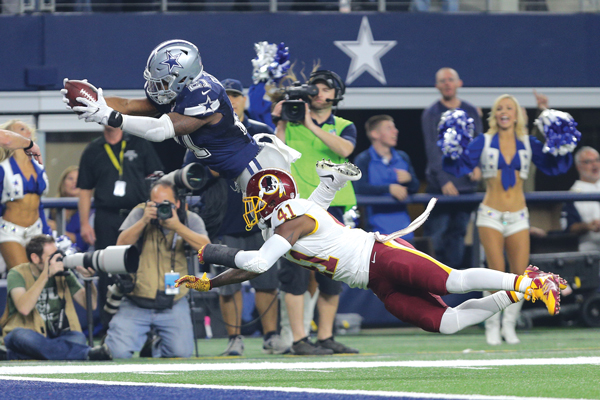Fox Sports averaged 35.1 million viewers for its Redskins-Cowboys game last Thanksgiving, making it the most-viewed regular-season NFL game in Fox Sports’ history and the NFL’s biggest regular-season TV audience since 1995.
Still, Fox Sports executives say that already record-setting viewership actually was 40 percent higher than reported. When combined with out-of-home viewership, the game averaged a whopping 48.7 million viewers.
 |
The out-of-home audience pushed viewership for Washington-Dallas to a whopping 48.7 million.
Photo by: GETTY IMAGES |
That 40 percent viewership increase is not a fluke, according to ESPN executives. They have seen similar increases when out-of-home audiences were added to its Christmas Day schedule of NBA games, according to Kelly Johnson, vice president of advertising and marketing intelligence for ESPN.
The development of Nielsen’s out-of-home system is one of the most closely viewed happenings in sports TV this fall, particularly when the NFL kicks off. After a season that saw NFL ratings fall by close to 10 percent, the increases that come from out-of-home ratings could build momentum for NFL telecasts that saw their biggest TV ratings drop in years, network executives say.
The out-of-home premise is simple: Nielsen wants to count viewers watching television outside of their homes and has created an audience sample to register viewing from bars, restaurants, hotels, work, second homes, etc. People in the Nielsen sample carry a device the size of a pager that picks up audio encoding from a nearby television. The key is to pick up audio — people watching in bars or an airport where there is no sound are not counted, even if they are watching.
The chart below shows that out-of-home viewers ages 6 and up for last Thanksgiving's Redskins-Cowboys game provided a 42 percent lift in overall viewership for Fox Sports, representing a gain of 13.6 million viewers.
| P6+ |
P18-34 |
P18-49 |
P25-54 |
M18-34 |
M18-49 |
M25-54 |
| Lift |
(000s) |
Lift |
(000s) |
Lift |
(000s) |
Lift |
(000s) |
Lift |
(000s) |
Lift |
(000s) |
Lift |
(000s) |
| 42% |
13,601 |
54% |
3,463 |
48% |
6,573 |
43% |
6,286 |
49% |
1,783 |
43% |
3,456 |
38% |
3,282 |
Source: Fox Sports
So far, ESPN and Fox Sports are the only networks to sign up for the ratings. CBS and NBC are having discussions with Nielsen, but neither has decided whether to sign on.
“We are currently working with Nielsen to ensure that its out-of-home methodology accurately reflects the full audience picture,” an NBCUniversal spokesperson said via email.
NFL Network likely will participate in Nielsen’s out-of-home measurement, according to an NFL source.
“Fox has been enthusiastic and recognized the potential in out-of-home from early on,” said Mike Mulvihill, executive vice president of research, league operations and strategy at Fox Sports. “If we are not making our best effort as a company to capture all of the viewing that there is around our content then we’re not maximizing the value of that content and we’re selling our product short.”
First Look podcast, with out-of-home viewership discussion beginning at the 7:20 mark:
Out-of-home ratings are not without their skeptics. Ad buyers question how much value they should assign to an out-of-home viewer — is someone watching television at a restaurant really as engaged as someone watching from home? Ad buyers also push back on the higher price tag ESPN and Fox are seeking, saying that they already are paying for out-of-home viewers as part of their traditional advertising buys. Plus, the delay in reporting out-of-home numbers presents problems. Currently, it takes a couple of weeks for Nielsen to come up with the out-of-home number. Nielsen has assured network executives that the lag time will soon be shortened.
So far, most out-of-home stories in the press have focused on sales — and with good reason. Everyone wants to know how this change will affect revenue.
But if these out-of-home numbers stand, they will have a big impact in how executives program their channels. Traditionally, networks try to avoid Friday and Saturday nights, as fewer people stay home and watch television on those nights.
| |
P2+ |
P18-34 |
P18-49 |
P25-54 |
| Around the Horn |
14.0% |
16.6% |
15.7% |
14.5% |
| College GameDay |
8.4% |
11.7% |
9.9% |
9.1% |
| Pardon the Interruption |
10.9% |
14.8% |
13.0% |
11.8% |
| SportsCenter 12 a.m. |
4.6% |
5.3% |
5.0% |
4.4% |
| SportsCenter 6 p.m. |
14.2% |
16.2% |
15.3% |
14.8% |
| |
P2+ |
P18-34 |
P18-49 |
P25-54 |
| CFP Championship |
4.2% |
8.0% |
6.3% |
5.5% |
| College basketball reg. season |
9.2% |
13.9% |
12.9% |
11.6% |
| College football afternoon |
10.3% |
16.8% |
14.1% |
12.4% |
| NBA regular season |
9.2% |
10.5% |
10.7% |
10.7% |
| Monday Night Football |
7.0% |
11.0% |
9.4% |
8.0% |
| Tennis U.S. Open afternoon |
12.3% |
23.9% |
21.1% |
17.9% |
Source: Nielsen Media Research, Aug. 29, 2016 - June 11, 2017
For example, the traditional TV ratings for World Series Games 1 and 2 last season (Tuesday and Wednesday nights) were higher than the traditional TV ratings for Games 3 and 4 (Friday and Saturday nights). But once the out-of-home audience was counted, Games 3 and 4 had bigger audiences than Games 1 and 2.
“There’s a path to Friday prime time being just as dominated by sports as Saturday prime time is right now,” Mulvihill said. “But we’re going to have to go through this out-of-home transition to get there and really take full advantage of that night.”
Fox and ESPN executives are energized by the numbers they are seeing from out-of-home ratings — and not just from the overall audience lift. Both ESPN and Fox said the out-of-home audience makeup is younger, more ethnic and more affluent.
“What we’re seeing is that all of the areas where traditional TV usage tends to be a little bit lower, the out-of-home ratings are disproportionately strong,” Mulvihill said.
ESPN also has found that more women are counted in its out-of-home audience than in-home. “That stands out the most to me,” Johnson said.
Johnson said out-of-home is helping more than just live sports. Studio shows like “Around the Horn” (up 14 percent) and early evening “SportsCenter” (up 14 percent) have seen considerable jumps with out-of-home ratings. “PTI” is up 11 percent, and “Monday Night Football” was up 7 percent last season.
John Ourand can be reached at jourand@sportsbusinessjournal.com. Follow him on Twitter @Ourand_SBJ.





